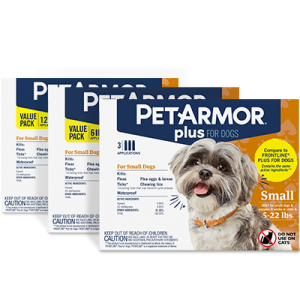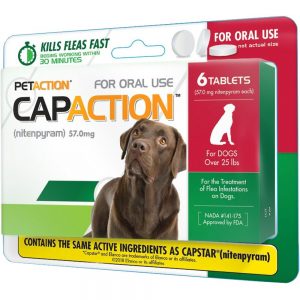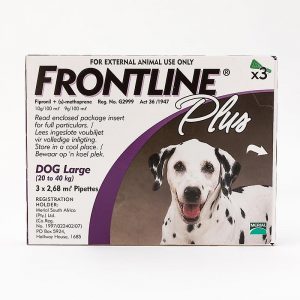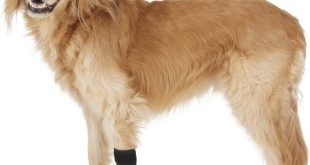Dogs are notoriously known for biting and scratching themselves. It’s not uncommon to see a dog trying to reach a sweet spot behind its ear or struggling with something on its tail. Guess what? Those are fleas!
Flea season is one of the things you’ll learn to dread as a dog owner. They’re almost unavoidable. At some point or another, they’re bound to find their way onto your dog’s fur. Unless you know how to prevent and treat flea infestations, both you and your dog are in for a rough time (pun intended).
The good news is that if you start early and treat flea infestations as soon as they arise, you can get rid of them in no time. Even if it’s just one or two fleas, you’re already running behind and need to act quickly.
Best Products for Treating Fleas in Dogs
-
Product on sale
 PETARMOR Fast Acting Flea and Tick Prevention- 3 CountOriginal price was: $42.00.$39.00Current price is: $39.00.
PETARMOR Fast Acting Flea and Tick Prevention- 3 CountOriginal price was: $42.00.$39.00Current price is: $39.00. -
Product on sale
 Oral Flea Treatment for Large Dogs from CapAction-25lbs and Over- 6 CountOriginal price was: $29.00.$25.99Current price is: $25.99.
Oral Flea Treatment for Large Dogs from CapAction-25lbs and Over- 6 CountOriginal price was: $29.00.$25.99Current price is: $25.99. -
Product on sale
 Frontline Plus Flea and Tick Treatment for Large Dogs 6 Dose 45 to 88 lbsOriginal price was: $53.00.$48.50Current price is: $48.50.
Frontline Plus Flea and Tick Treatment for Large Dogs 6 Dose 45 to 88 lbsOriginal price was: $53.00.$48.50Current price is: $48.50.
What are Fleas?

Let’s not dwell on the obvious. Fleas aren’t a mystery: we’ve all heard of or seen fleas at some point or another. The question is, what are these little bouncy creatures and why do they have it out for our dogs?
As usual, science has an answer for everything. Strictly speaking, fleas can be classified as insects. They’re small, brown parasites that feed off of your pup’s body and reproduce, often leading to an infestation.
Despite popular opinion, these pesky little insects don’t just affect dogs in the summer. They might prefer temperatures of 65-80 degrees Fahrenheit and humidity levels of 75-85%, but they can cause infestations in dogs year-round.
All it takes is for one flea to find its way onto your pup’s fur and in a few weeks, you might be facing a full-blown infestation. Luckily, these tiny parasites don’t have wings and they can’t just fly around looking for a cute, harmless pup to infect.
Fleas have strong hind legs that allow them to literally jump onto the perfect host, which just happens to be your furry buddy. They then start biting your dog’s skin, which can cause irritation, itching, hair loss, and allergic reactions.
Where do Fleas come From?
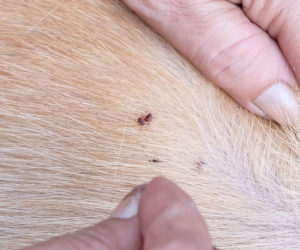
Before we get to treating and preventing flea infestations in dogs, you first need to understand where they come from. Generally speaking, fleas start out as eggs that are found in shady, protected, outdoor areas. They tend to thrive where there’s no sunlight.
Your dog can get infected just by being in such an environment and sooner or later, you might find yourself dealing with a flea infestation. Here are a few examples of how your dog can come in contact with fleas.
Infested Wildlife
You know those possums your pup likes to chase around at night? What about foxes, raccoons, skunks, and even stray cats? All of these can be potential carriers of fleas and can contribute to a flea infestation.
More often than not, these animals might be carrying adult fleas, eggs, or even larvae. Even if they don’t come in direct contact with your dog, they can drop these pesky parasites and leave them lying around for your dog to pick up. Next comes the infestation.
Common areas that are infested
There are places where almost all dogs meet, go, or pass through at some point or another. All it takes is one infected dog with a few flea eggs and there you go: all the dogs that follow suffer an infestation.
You might not even realize it but places like rest areas, dog daycares, and even parks are full of fleas and flea eggs.
Guests
You can’t really control this one but it’s true nonetheless. Sometimes a houseguest can be the source of your newfound flea infestation. If they have infected pets or if they have carried in some sort of eggs or larvae, chances are they will transmit the infection to your dog.
Whether it is a family visit or a pet date, there is always a possibility that your pup might acquire a few fleas. Left untreated, these fleas can then become a full-blown infestation.
Fleas have no rules. They can stroll right into your home on the back of a friend or ride in on any four-legged creature, be it a cat, dog, or even a hamster. Always be on the lookout for signs of a flea infestation and try to connect the dots to find out what brought them in.
Life Cycle of Fleas– How Flea Infestations Start
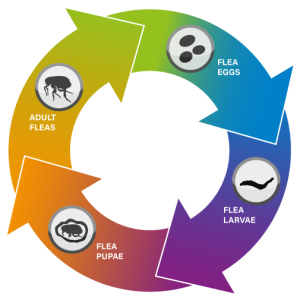
If you really want to prevent and treat flea infestations in dogs, you need to understand everything about them. Their life cycle, how they start out, how they develop, and which stages treatments can target to get rid of them. Luckily, the life cycle of fleas is pretty simple.
Stage 1: Flea Eggs
First, they start out with eggs which are released by the adult female fleas. Unfortunately, females can release about 50 eggs a day. Multiply that by a reproduction period of a month or two and you’ll have over 2000 eggs on your hands in no time!
These eggs are transferred from your pup to its surroundings like carpets, the backyard, the bed, and almost any form of fabric.
Stage 2: Flea Larvae
After some time, these flea eggs start to hatch and become larvae. This process varies but usually takes from one to ten days. There’s a good chance these larvae might die but only if they’re hatched in unfavorable conditions.
In most cases, however, these larvae find themselves in moist, dark areas with free access to organic debris. They eventually thrive and cause flea infestations. This is why you’ll find flea eggs and larvae common in areas like:
- Carpets
- Beds
- Areas in your backyard that don’t get enough sunlight
- Under furniture and baseboards
- Tucked-away fabrics
Stage 3: Flea Pupae
The next stage of a flea infestation in dogs is the pupae. It sounds complicated but it’s quite simple. The larvae just wrap themselves in sticky, silk-like material, turning into a sort of cocoon. Pupae can stay in this state for weeks or even months at a time.
That’s why flea infestations in dogs often appear a few weeks after returning from vacation or changing your pup’s surroundings.
Stage 4: Adult Fleas
This is the stage we’re most familiar with in flea infestations in dogs. Full-grown adult fleas start biting your pup almost immediately and cling on for dear life.
Most people think that fleas jump from one dog to another or onto any pet that comes their way but this actually isn’t true. They can’t fly. Otherwise, flea infestations in dogs would be self-limited and they’d eventually go away.
In reality, fleas like to stick to one pet at a time, feeding, thriving, reproducing, and laying eggs. This cycle could go on and on for months until you finally have a full-blown flea infestation that could be difficult to treat.
Treatment of Flea Infestations in Dogs
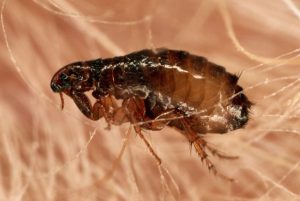
Before we get into treating flea infestations, let’s consider for a second: do we really need to do something about them or will they just go away if we ignore them? Unfortunately, unlike a common cold, flea infestations are not self-limited.
If you ignore them, they’ll just get worse and worse. They’ll spread from one pet to another until you have a whole flea circus at home! Luckily, there are several ways you can treat a flea infestation. Let’s start with natural remedies first.
Natural Treatments for Flea Infestations in Dogs
Lots of people prefer natural remedies to chemical-based products. You never know what kind of side effects you might have to deal with later on. Luckily, there are several all-natural ways you can get rid of flea infestations in dogs.
Coconut Oil
You’ve probably heard of coconut oil being the solution to all of life’s problems. Well, now we can add flea infestations to the list. All you need to get rid of your dog’s fleas is a decent amount of pure coconut oil. How does it work? There are several mechanisms.
First of all, coconut oil contains a large amount of a substance called lauric acid. Normally, lauric acid isn’t very important but after you apply it to your pup, it transforms into another compound called monolaurin. This is when the magic starts.
Monolaurin is known for its ability to kill off fleas. Not only that, but monolaurin also has soothing and antiseptic properties. It helps calm your dog’s skin and quells the inflammation and irritation associated with flea bites and infestations.
Benefits of using Coconut Oil
The antiseptic properties of coconut oil also help fight infections that are common in more severe flea infestations.
The best part is that coconut oil goes to work in a matter of hours. After applying it to your pup’s fur, it won’t take long before coconut oil works its magic.
It’ll soothe your dog’s skin, fight off infections from those nasty flea bites, kill the little critters, and even prevent future infestations. Coconut oil really does it all. Here’s how to use it.
How to use Coconut Oil
There are three ways you can use coconut oil to get rid of flea infestations. The first method is the most obvious. You can just rub it into your pup’s fur. Let it sit for about 10 minutes before applying shampoo and rinsing it off.
Another thing you can do is mix the shampoo with the coconut oil. A 1:1 ratio should do the trick. This time, rub the mixture into your pup’s fur and wait another 10 minutes before rinsing.
This last method is a bit untraditional and to be honest, isn’t the fastest remedy. You can feed your pup the coconut oil. It’ll be just as effective, but it’ll take some time. Start with a dose of 1 teaspoon for every 20 pounds your dog weighs.
Epsom Salt
Epsom salt might be nice and relaxing for us, but it’s deadly to fleas. Epsom salt has a dehydrating effect on fleas, making adult fleas, larvae, and even eggs dry up, wither, and die.
You might be asking yourself, why can’t I just use regular old salt? Won’t it work? Well, technically, regular table salt should also do the trick. However, if your pup has any open cuts or sores, it will be pretty painful.
Besides, Epsom salt has tons of other benefits besides fighting flea infestations in dogs. It’s full of magnesium and sulfur which act as topical antibiotics, have anti-inflammatory properties, soothe your pup’s skin, and even jumpstart your dog’s immune system!
All you need to do is soak your pup in an Epsom salt bath for about 10 minutes and then rinse it off. Make sure you don’t leave any of the salt behind.
Baking Soda
Here’s another easy home remedy for flea infestations. Much like Epsom salts, baking soda can penetrate fleas’ exoskeletons and dry them up from the inside and they eventually die. It might take a bit more time, but it works, nonetheless.
Flea Collars
While this isn’t really a “natural” remedy, it does save you the trouble of having to use a bath or give your pup some kind of medication. Flea collars are simple, you just strap them on and they get to work.
Over the years, flea collars have improved a lot. Historically, they were known for preventing flea infestations, but not treating them. Now, however, there’s more technology being put into these collars.
Some flea collars emit a special gas that can keep fleas away and even kills them. The gas is undetectable to your pup and of course, completely safe. While these collars are usually used to keep fleas away, other collars can be used to treat more severe infestations.
For example, there are specially-designed flea collars that secrete a unique kind of medication that kills off fleas. This substance binds to your dog’s natural oils and then gets absorbed into its skin’s fatty layers for a deeper level of treatment.
Commercial Treatments for Flea Infestations
While natural products are usually the better choice, there are times when the flea infestation is so severe, you need a stronger weapon to fight back. There are several products that are chemical-based, but perfectly safe to use for your dog.
Topical Treatments
Topical treatments are a great option if you want to tackle a specific spot that’s been itching your pup for a while. Most topical flea medications usually start working in about 4 hours. They pick off those fleas one by one.
About 12 hours in, your dog should be almost completely infestation-free! There are several products to choose from but generally, they all contain one of three main ingredients: permethrin, imidacloprid, or (S)-methoprene.
Some of the most popular topical flea medications on the market include Frontline, Bravecto, Advantix, Vectra 3D, and Simparica. All of these specifically target parasites and fleas, getting rid of your infestation problem once and for all!
Oral Treatments
Believe it or not, oral flea medication works even faster than topical solutions! Oral treatments start working just two hours after administration. Generally speaking, oral flea medications contain one of four components: afoxolaner, fluralaner, spinosad, or nitenpyram.
All of these are highly specific and they target various stages in the fleas’ life cycle. The only problem with oral flea treatments is that unlike topical products, they’re usually prescription-only, which means you won’t find them off-the-counter at your local pharmacy.
Some of the best oral medication for fleas include Bravecto, NexGard, Capstar, Comfortis, and Simparica.
How do I choose the Right Flea Treatment?
It really comes down to your personal preference and how severe your dog’s flea infestation is. That being said, you generally want a flea remedy that is:
- Easy to apply
- Fast-acting
- Long-lasting
- Effective on other pests like ticks, as well
- Safe for your pup’s age
- Easy to get at your local pharmacy
How Flea Infestations Affect your dog’s health – Symptoms
Besides being extremely annoying, flea infestations have a number of health issues you should consider. These little critters can cause more than a bit of itching and scratching. That being said, let’s start with the most obvious one.
Itching
Itching is the most common problem you encounter when you have a flea infestation on your hands. However, while itching is pretty bad, it’s not the main concern when it comes to your pup’s health. It’s what itching can lead to that you want to worry about. Things like hot spots, for example.
Hot Spots
Hot spots are a form of severe inflammation caused by excessive itching. It happens when your dog focuses on one spot for too long, itching and licking away. What’s the problem with that, you might ask? Well, it’s not a problem now but sooner or later, the constant attack on one area makes the skin in that area break down.
Once the skin is no longer intact, there’s nothing protecting your pup from infection! Yes, a regular, old-fashioned flea infestation can turn into a serious infection. As long as your dog’s skin is damaged, it becomes exposed to all kinds of environmental threats.
Infections can be quite severe if you don’t treat them in time. As soon as you suspect your pup might have a hot spot, take a trip to the vet. They’ll be able to determine whether or not there’s a risk of an infection and if your flea infestation has become something more serious.
Allergic Dermatitis
Another thing flea infestations can cause is allergic dermatitis. To put it simply, it’s an allergic reaction of the skin that involves inflammation. What is your dog’s skin reacting to? Yes, you guessed it. The flea infestation. Sometimes allergic dermatitis settles down on its own, but after quite a while.
In most cases, however, it can lead to other complications. Things like dry, flaky skin and oily, greasy skin are manageable. Things like hair loss and painful skin lesions aren’t. Don’t let flea infestations turn into a figurative and literal pain for your pup.
Anemia
Another thing you might have to worry about is anemia. The more fleas, the more anemia becomes a risk. Why? Well, let’s think about it for a second. Why do fleas hide themselves in your dog’s fur in the first place? Definitely not for the ride. It’s so they can hide safely while feeding off of your dog’s blood. They’re like tiny vampires without wings.
Unfortunately, when you’ve got a flea infestation on your hands, that’s too much blood loss for your pup. It becomes anemic. The more fleas your dog has the weaker and more lethargic you’ll notice it becoming. In very severe cases, some dogs have required blood transfusions!
Tapeworms and Fleas
This one’s going to sound a bit far-fetched. How do fleas give your dog worms? Well, it’s true. Bear with me and you’ll understand how. When your dog has a flea infestation, it keeps biting and licking itself, right? Well, there’s a chance it might swallow up a flea or two during one of its licking adventures, right?
And what if one of those fleas was infected with tapeworms? It’s more than possible. Now your pup has tapeworms inside it. Sooner or later, you’ve got fleas and a tapeworm infection on your hands. It sounds like a long shot but it really does happen.
Once those tapeworms are inside your pup, they cling onto its intestinal lining with their teeth. Next comes all the usual symptoms of a tapeworm infection like vomiting, perianal itching, and white grain-like substances appearing in stool.
If your pup has a flea infestation and you begin noticing any of these signs or symptoms, you should talk to your vet about the possibility of a secondary infection.
Treating the Environment
Now that’s you’ve successfully treated your pup, you want to make sure those pesky fleas don’t come back. Unfortunately, there’s a good chance your dog has already spread the fleas to your surroundings. Your house might be flea-ridden even if your dog is now flea-free! It’s important to treat your environment, as well, to make sure your dog stays safe.
Indoor
Start with your indoor objects. First, take all of your bedding and wash them with soapy, hot water. This should get rid of any residual fleas that are still bouncing around. Next comes the carpets. Vacuum them thoroughly and then throw away the vacuum bag or empty it carefully. You might also want to steam clean the carpet to get rid of any residual larvae.
That being said, vacuuming and shampooing carpets often leave a few live fleas behind. All it takes is one little critter to make it out alive and you’ll have another flea infestation on your hands in no time. That means you’ll need some sort of chemical treatment sooner or later.
There are tons of products to choose from including foggers, which are quite effective. If you have children or small pups at home and are worried about the idea of chemical treatments, you can always go with boric acid-based products. They’re much safer.
Targeting Adult Fleas
Normally, when treating your dog’s environment, you want something that’ll kill the adult fleas themselves and then something that’ll kill off all the other stages in the flea’s life cycle. The latter is called an insect growth regulator. These have to be very specific and effective, otherwise, fleas will just continue on with their cycle like nothing’s happened.
For example, Methoprene is a good insect growth regulator that kills off the different stages of a flea life cycle. On the other hand, aerosol foggers might not have what it takes. They don’t have enough penetrating power to get to all the larvae and hidden fleas.
Another thing you can use to get rid of indoor carpet fleas is a sodium borate-based product. Of course, there’s always another option you can opt for, although it might be expensive. You can call an exterminating company and get an estimate on how much it would cost to rid your house of fleas.
Outdoor
When it comes to the outdoor environment, you can use things like sprays and pelleted insecticides after cleaning dog houses and god kennels thoroughly. A good choice would be an insect growth regulator in the form of a spray.
While Methoprene works great, it might be better to use Pyriproxifen when treating outdoor environments for fleas. It’s more stable in sunlight and lasts longer so its effect is more guaranteed.
One non-toxic option you can opt for is diatomaceous earth. It’s perfectly safe to use outdoors especially if your children leave toys and equipment laying around. You can also use it in vegetable gardens and it won’t affect the food. The best kind of diatomaceous earth is the food-grade type.
Another weird, yet effective method of preventing flea infestations is by deploying a small army of nematodes in your gardens. Sounds crazy, huh? Well, here’s why putting tiny worms in your yard is a good idea.
These tiny nematodes can feed on flea larvae. They basically kill off an important part of the flea’s life cycle and therefore, protect your dog from flea infestations. It’s unconventional, yes, but effective.
Frequently Asked Questions- Flea Infestations
Do flea infestations only happen in the summer?
It’s common knowledge that fleas prefer the summer. Their ideal weather is somewhere around 70 degrees Fahrenheit with 75-85% humidity. However, that doesn’t mean they can’t survive in colder environments.
Fleas can thrive and cause some of the worst infestations you might experience even in the coldest of winters. All they need is a warm host to live on which in this unfortunate case, is your furry buddy.
That being said, flea infestations are much more common in hotter, more humid environments so be extra careful in the summer.
Are Some Dogs more Susceptible to Flea Infestations than others?
Fleas are the only creatures that might love your dog as much as you do. They simply can’t stay away and usually cling to your pup with everything they’ve got. That being said, you might find that some pups are more of a flea-magnet than others.
It all comes down to the kind of environment a host like your pup can provide for the fleas. Dogs that lick and bite themselves excessively tend to create a moist, saliva-rich environment that is ideal for flea infestations.
This attracts more fleas which bite your dog causing even more itching, biting, and licking which in turn creates more saliva. Then this saliva attracts another fleet of fleas. The cycle never ends.
Another thing fleas like is a long, thick coat of fur. It provides them with safe refuge where they can hide without being scratched or kicked out. Dark fur is even better because it makes it harder to spot fleas.
Long floppy ears and or a long tail that curls up onto your dog’s back are great hiding places for fleas. They can easily settle down and start an infestation.
How do I know if the Fleas are Gone?
Unfortunately, there’s no easy way to be absolutely sure your dog and your house are flea-free. That being said, after treating your dog and disinfecting your environment, be on the lookout for flea-related signs.
If you notice your pup scratching, itching, or chewing its tail, then your job might not be over yet. You should also pay attention to things like hair loss and sensitivity to touch.
Conclusion
There’s nothing worse than waking up to find your furry little buddy has become a moving party bus for fleas. The good news is that fleas aren’t hard to fight. Nor prevent. You just need to know which products to use and what precautions to take.
Always take care of your dog’s environment and put in a little extra effort to keep fleas away and you won’t have to worry about infestations. That being said, it’s nice to know there are some safe, effective, and perfectly-good treatments out there should your pup need them.
If you’re not sure whether or not your dog has a flea infestation, don’t hesitate for a moment. Contact your vet right away before the situation jumps out of your hands.
 Total Pooch Dog Supplements, Tear Stain Removers, De-wormers, Tylosin for Dogs and other great products.
Total Pooch Dog Supplements, Tear Stain Removers, De-wormers, Tylosin for Dogs and other great products.



